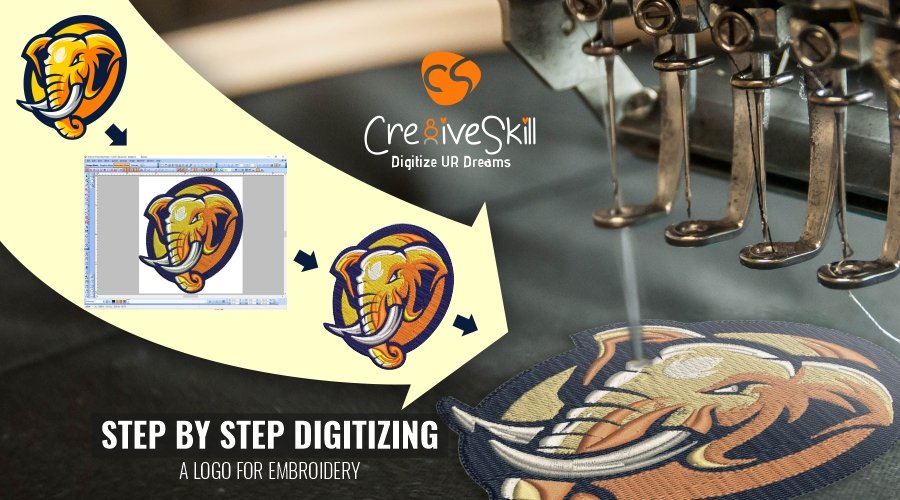Ideal Digitizing for Embroidery: Boost Your Tasks
Ideal Digitizing for Embroidery: Boost Your Tasks
Blog Article
Mastering the Needlework Digitizing Refine: Your Ultimate Overview
Needlework digitizing is a careful craft that calls for accuracy and knowledge to equate elaborate styles into digital formats for machine embroidery. As craftsmens get started on this trip to master the needlework digitizing process, an extensive understanding of the fundamentals sets the foundation for quality.

Recognizing Needlework Digitizing Essentials
Needlework digitizing essentials develop the structure whereupon complex styles are equated into machine-readable formats for accurate stitching. This initial action in the embroidery digitizing process is essential for guaranteeing that the final embroidered product is a faithful representation of the original design. Understanding embroidery digitizing essentials involves grasping key concepts such as stitch kinds, sew instructions, thickness, rug, and pull payment.
Stitch types play a vital role in determining the visual and textural outcome of the stitched layout. By picking the ideal stitch kind, whether it be satin, fill, or running stitch, digitizers can attain the wanted result and improve the general quality of the embroidery. In addition, sew instructions affects the circulation and dimension of the style, while density establishes the spacing and protection of the stitches.
Moreover, rug stitching provides security to the layout by securing the textile and stopping distortion throughout the embroidery process. Draw payment is another important factor to consider to combat the natural propensity of material to contract when sewn. Mastering these needlework digitizing fundamentals is fundamental for developing professional-quality embroidered products.
Choosing the Right Digitizing Software Program
Selecting the suitable digitizing software is an important decision that dramatically impacts the performance and top quality of the embroidery digitizing process. Digitizing for Embroidery. When picking the right digitizing software application, it is important to think about factors such as the complexity of styles you intend to create, the user-friendliness of the software application, the degree of customer support used, and the compatibility with your needlework device
There are various digitizing software application alternatives readily available in the market, varying from standard programs for newbies to innovative software program for professional digitizers. Some popular choices consist of Wilcom EmbroideryStudio, Hatch Needlework Software Program, and PulseID. These software program packages offer a vast array of tools and functions to aid you develop intricate designs with ease.
Before choosing, it is a good idea to check out the various software program alternatives through free tests or demos to establish which one ideal matches your requirements. Furthermore, checking out evaluations and seeking recommendations from skilled digitizers can offer valuable insights right into the staminas and weaknesses of each software package (Digitizing for Embroidery). By carefully evaluating your needs and comparing the functions of various digitizing software program, you can make an educated selection that improves your needlework digitizing operations
Digitizing Devices and Strategies

Optimizing Design Settings for Needlework
Understanding the complexities of style setups is basic in achieving ideal lead to the needlework digitizing process, structure upon the structure laid by comprehending digitizing devices and techniques. When enhancing layout settings for embroidery, it is crucial to consider variables such as stitch type, density, underlay, draw compensation, and enrollment. Stitch kind option impacts the general feel and look of the style, with alternatives like satin, fill, and running stitches offering various appearances and results. Thickness describes the spacing and density of stitches, affecting the design's coverage and resilience. Proper rug sewing offers stability and prevents textile distortion, particularly for complicated layouts or on elastic materials. Draw payment adjusts for textile stretch during sewing, making sure precise layout replication. Enrollment settings align various elements of the layout precisely, keeping general design stability. By fine-tuning these design setups, embroiderers can enhance the top quality and precision of their stitched developments.

Troubleshooting Common Digitizing Issues
When coming across common digitizing concerns during the needlework process, it is vital to recognize moved here the root creates and execute reliable options quickly. One usual issue is stitch thickness problems, where stitches may be also thick, creating the material to tighten, or also sparse, causing spaces in the style. Readjusting the stitch density settings in the digitizing software can assist solve this concern.
An additional frequent challenge is thread breaks throughout the embroidery process. This can happen as a result of different factors such as incorrect tension settings, boring needles, or utilizing low-grade string. Making certain correct upkeep of the needlework machine, including regular needle changes and tension adjustments, can reduce the incident of thread breaks.
Moreover, design registration errors can result in misaligned elements within the embroidery design. Checking the design alignment in the digitizing software and making necessary changes prior to sewing can assist in avoiding this problem. By dealing with these common digitizing issues without delay and successfully, you can make certain a smoother needlework process and top quality completed products.
Conclusion
To conclude, understanding the needlework digitizing process requires a strong understanding of the essentials, the ideal choice of software, and expertise of devices and methods. Maximizing layout settings and troubleshooting usual digitizing problems are important action in making certain high-grade needlework results. By adhering to these steps diligently, one can attain precision and efficiency in the digitizing procedure.
Report this page